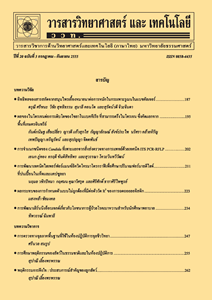การประเมินลักษณะทางสัณฐานวิทยาของเมล็ดและปริมาณสารประกอบไขมันของข้าวโดยใช้การวิเคราะห์หลายตัวแปร
Main Article Content
บทคัดย่อ
ความหลากหลายทางพันธุกรรมของข้าวมีความสำคัญต่อการปรับปรุงพันธุ์ข้าว ดังนั้นการวิจัยครั้งนี้จึงมีวัตถุประสงค์เพื่อประเมินลักษณะทางสัณฐานวิทยาของเมล็ด แอลฟาโทโคฟีรอล และแกมมาออไรซานอลในเชื้อพันธุกรรมข้าว 81 สายพันธุ์ เปรียบเทียบร่วมกับพันธุ์ขาวดอกมะลิ 105 และ กข. 6 ด้วยวิธีวิเคราะห์หลายตัวแปร (multivariate analysis) ประกอบด้วยการวิเคราะห์ข้อมูลทางสถิติ การวิเคราะห์ส่วนประกอบหลัก และการวิเคราะห์แบ่งกลุ่ม ผลจากการศึกษาพบว่าทุกลักษณะที่ศึกษามีความแตกต่างกันทางสถิติ โดยมีความแปรปรวนทางพันธุกรรมสูงสำหรับสัณฐานวิทยาของเมล็ด (7.72-30.99 %) แอลฟาโทโคฟีรอล (49.82 %) และแกมมาออไรซานอล (23.39 %) นอกจากนี้การวิเคราะห์ส่วนประกอบหลักและการวิเคราะห์แบ่งกลุ่มของลักษณะทางสัณฐานวิทยาของเมล็ดให้ผลสอดคล้องกันและสามารถจัดกลุ่มเป็น 9 กลุ่ม ขณะที่การวิเคราะห์แบ่งกลุ่มของปริมาณแกมมาออไรซานอลและสารแอลฟาโทโคฟีรอลสามารถจัดกลุ่มเป็น 9 กลุ่ม โดยกลุ่มที่มีปริมาณสารประกอบไขมันดังกล่าวสูงสุด 14 สายพันธุ์ คือ สันป่าตอง นางบุญมา สาวอุดร ปลาเข็ง เจ้าปทุมมา เหรียญทอง เหลืองบุญมา ฮ้าว หอมสังฆ์ทอง หอม อีด่าง ข้าวช่อราตรี LG2751 และหอมทุ่ง 1 ผลจากการศึกษาครั้งนี้เป็นประโยชน์สำหรับนักปรับปรุงพันธุ์ในการนำไปคัดเลือกเชื้อพันธุกรรมข้าวเพื่อการพัฒนาสายพันธุ์ข้าวให้มีสารประกอบไขมันที่มีฤทธิ์ทางเภสัชสูงในอนาคต
Article Details
References
Liu, R.H., 2007, Whole grain phytochemicals and health, J. Cereal Sci. 46: 207-219.
Mira, N.V., Massaretto, I.L., Pascual C.S. and Marquez, U.M., 2008, Comparative study of phenolic compounds in different Brazilian rice (Oryza sativa L.) genotypes, J. Food. Compost. Anal. 22: 405-409.
Thai Rice Exporters Association, Rice Production, Available Source: https://www.thairiceexporters.or.th/production.htm, December 20, 2018. (in Thai)
Thitiprasert, W., Jaichagun, M., Makrua, T., Thongjuaphet, P., Raksasin, S., Deeman, A. and Wuttiyano, C., 2011, Rice Breeding Database: Rice Research Institute and the National Plant Protection Bureau Department of Agriculture, Agricultural Cooperative Assembly of Thailand Limited, Bangkok, 682 p. (in Thai)
Harlan, J.R., 1992, Crops and Man, 2nd Ed., American Society and Agronomy, Crop Science Society of America, Madison, WI., 284 p.
Oka, H.I., 1988, Origin of Cultivated Rice, Japan Scientific Societies Press, National Institute of Genetic, Misima, 254 p.
Khavari, K.S., Mostafavi K., Zandipour E. and Heidarian A., 2011, Multivariate analysis of agronomic traits of new corn hybrids (Zea may L.), Int. J. Agri. Sci. 1: 314-322.
Phodjanawichaikul, P., 2017, Characteristic and quality determination of Thai rice with multivariate analysis, Songklanakarin J. Plant Sci. 4(2): 56-65. (in Thai)
van Beuningen, L.T. and Busch, R.H., 1997, Genetic diversity among North American spring wheat cultivars: III. Cluster analysis based on quantitative morphological traits, Crop. Sci. 37: 981-988.
Madee, P., Theerakulpisut, P., Sanitchon, J., Lontom, W., Pattankul, W. and Pengrat, J., 2014, Evaluation of salinity and drought tolerance in landrace colour rice genotypes at seedling stage using multivariate cluster analysis, Thai J. Bot. 6(Suppl.): 211-218. (in Thai)
International Rice Research Institute, 2002, Standard Evaluation System for Rice (SES), International Rice Research Institute (IRRI), Los Banos, 56 p.
Butsat, S. and Siriramornpun, S., 2010, Antioxidant capacities and phenolic compound of the husk bran and endosperm of Thai rice, Food Chem. 119: 606-613.
Ismail, M., AL-Naqeeb, G., Mamat, W.A.A., and Ahmad, Z. 2010, Gamma-oryzanol rich fraction regulates the expression of antioxidant and oxidative stress related genes in stressed rat’s liver, Nutr. Metab. 7: 1-13.
Goufo, P. and Trindade, H., 2014, Rice antioxidants: phenolic acids, flavonoids, anthocyanins, proanthocyanidins, toco pherols, tocotrienols, γ-oryzanol, and phytic acid, Food Sci. Nutr. 2: 75-164.
Joralee, A., Banteng, P. and Kaewpradit, W., 2013, Evaluation of agronomic traits and gamma oryzanol content in black glutinous rice grown under upland condition, Khon Kaen Agric. J. 41(1): 618-623. (in Thai)
Boodseephum, P. and Wongtamee, A. 2017, Morphological diversity and cluster analysis of local rice varieties from lower north region, pp. 343-348, 13th Naresuan Research Conference, Phitsanulok. (in Thai)
Kajonphol, T., Paowsrakoo, N. and Sangsiri, C., 2012, Diversity of local upland rice varieties in Kanchanaburi province, Agric. Sci. J. 43(Suppl. 2): 601-604. (in Thai)
Thamwongsa, T., Sanitchon, J., Meesawat, A. and Itharat, P., 2012, Morphological and anatomical characters of lowland-black rice grains in the Northeast of Thailand, KKU Sci. J. 40(4): 1138-1148. (in Thai)
Shen, Y., Jin, L., Xia, P., Lu, Y. and Bao, J., 2009, Total phenolics, flavonoids, antioxidant capacity in rice grain and their relations to grain color, size and weight, J. Cereal Sci. 49: 106-111.
Juliano, B.O., 1997, Rice lipids, II Riso. 26: 3-21.
Boonsit, P., Pongpichan, P., Julsrigival, S. and Karladee, D., 2010, Gamma-oryzanol content in glutinous purple rice landrace varieties, CMU. J. Nat. Sci. 9(1): 151-157.

